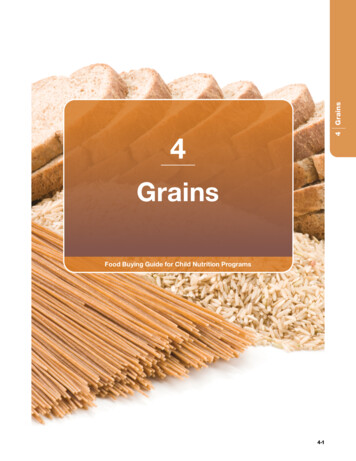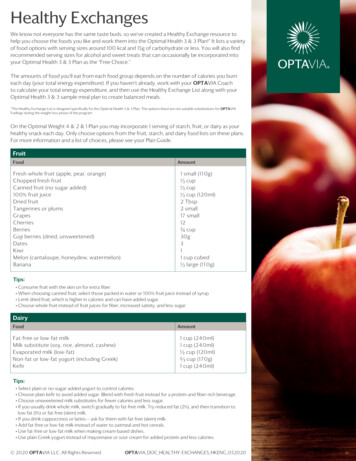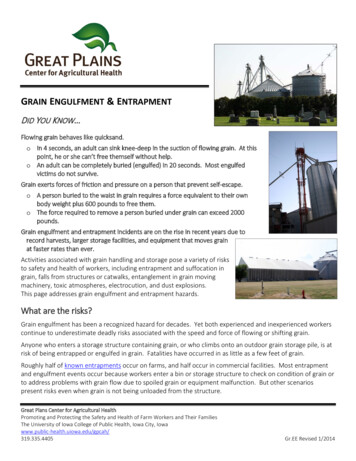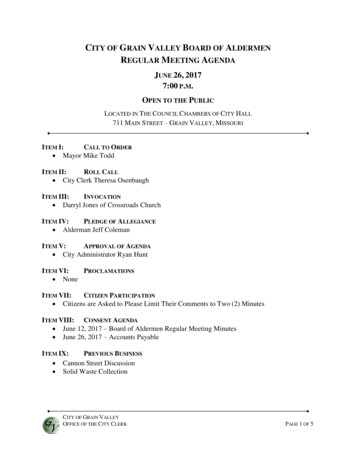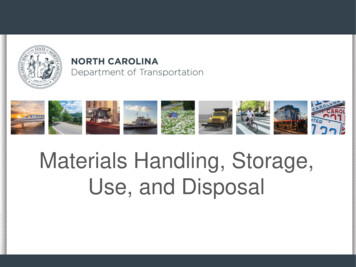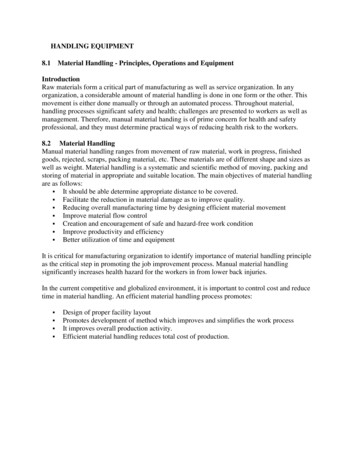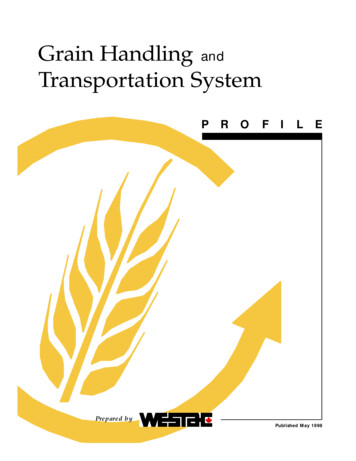
Transcription
Grain Handling andTransportation SystemPROFILEPrepared byPublished May 1998
ContentsPart 1The Canadian Logistics ChallengePart 2How the Present System Wo r k sPart 3Quick FactsPage 2
ThisReport is being provided to the Grain Review Secretariat.It has been completed for the Senior Executive Officers(SEO) group of western Canadian producers, graincompanies, pools, Canadian Wheat Board (CWB),railways, Prince Rupert Grain Limited, and the CanadianGrain Commission (CGC).This is the first report in the logistics project being carried out byWESTAC with SEO support and guidance. The content reflects WESTAC’sindependent corporate mandate of using a neutral and balanced approachto improve the transportation system.Before we debate changing the present system, we must have a commonunderstanding of how it functions. This report draws largely on existingresearch to describe a very complex grain handling and transportation system in a simple, easy-to-understand way. It is intended as a primer for theworkshops where more detailed information may be used. These workshops, which will occur in the second part of the logistics project, willidentify problems with the existing system and options for change, basedon comprehensive consultations with system participants.Please note:The term “grain” refers to the six major grains (wheat including durum, barley, rye,oats, flax, canola), the specialty grains such as peas and lentils, and grain products.The statistical information in this report is based on the most recent informationavailable. In many cases, multi-year averages are used to smooth out short termfluctuations. In some instances, representative figures are used to illustrate a pointrather than provide a detailed statistical account of the grain industry.The report contains several supply chain examples using West Coast movementsbecause they are typical of the majority of shipments in recent years.P ag e 3
part 1TheCanadianLogistics ChallengeThe need for an efficient, low cost grain logistics system isnot in dispute— less clear are the compromises needed toachieve this goal and still benefit all, especially the producer.Customers are the foundation ofour business, and our farmersproduce for them. Logistics tiesthem together.Logistics is a total system processencompassing all aspects of orderprocessing, storage and transport.However, it must be rememberedthat the most important factor inany logistics system is people—from those who are our customersto those who grow grain, and allalong the logistics pipeline, theworkers and managers and regulators who make the system work.What is needed?Producers need an excellentlogistics system: to maintain and improve theirsuccess in the global marketplace because logistics costs are thelargest input cost for grainproducers (Chart 1).Chart 1—Farm Input CostsAt the same time, grain companiesand transportation serviceproviders must earn competitivereturns on their assets which arean incentive to invest in the facilities needed to provide reliable andefficient services.How are we diff e re n t ?As other countries do, we meetour own needs first. What makesus unique is the large proportionof grain that we export, some twothirds of each year’s harvest.Worldwide, we rank third as agrain supplier, behind the US andEuropean Union. For several products (rye, canola, flaxseed, mustardseed) we are the world’s principalexporter. In the process, 130,000farmers in the western provincesgenerate over 11 billion annuallyfor the Canadian economy. Thedelivery system must respond tothese challenges.Logistics costs are typicallyin the range of 60 per tonne.What is the graintransportation environment?Large volumes (30 milliontonnes) are being exported eachyear, originating at many production points across the prairies,and destined for numerous customers. Domestic use is alsosignificant (16 million tonnes),half used on farm as livestockfeed or seed and the other halfdelivered to domestic flour mills,feed mills, oil processing plants,brewers, maltsters and distillers.The St. Lawrence Seaway routethrough Thunder Bay was once themain grain export route. RisingPacific Rim markets have made theWest Coast the major outlet (61%of export volume). However, grainremains vital to the St. Lawrencesystem (40% of total eastboundSeaway traffic). It is also importantto the economics of Lake shippingbecause it helps balance cargoflows (i.e., eastbound grain andwestbound iron ore destined toUS/Canadian steel mills).Several factors affect westernCanadian system capacity: grain purchases are spreadthroughout the year, but demandand prices are seasonal, tendingto be higher between Octoberand March the rail and port systems servedifferent needs (many segregations of grains, large volumes ofother commodities, intermodaltraffic) St. Lawrence Seaway is closedfor the winter months.The CWB, as a single-deskmarketer of wheat and barley,ships over 60% of the grain in thelogistics system. As the CWB doesnot own elevator assets, it reliesPa g e 4
on the competitive, privatelyowned grain companies and poolsto fill its orders. These centrallymarketed grains must share thesame facilities with open marketgrains, such as canola or rye.Most storage is located on farms,not part of the commercial supplychannel. Commercial storage inthe country (primary elevators)and at export terminals is verylimited compared to that of ourcompetitors (Chart 2). Efficient useof this capacity depends on boththe absolute capacity and theturnover rate. It is vital to bringthe right grain into and throughthe system when it is needed.Clogging the system with“unneeded” grains can quicklyimpede product flows.Chart 2—Exports as a Percent ofCommercial StorageSource: Canadian Wheat BoardNo one party controls the supplyof products or the logistics system.Unlike other commodities, ingrain there is no overall authorityor responsibility for all logisticsfunctions.Most producers are located athousand miles or more fromexport terminals with practicalaccess to only one railway. Thecountry elevators are widely dispersed and often in remotelocations. Rail is the only viablemode of inland transportation. Alarge fleet (up to 27,000 rail cars)is needed to move products.Nearly three-quarters of this fleethas been purchased or leased byfederal/provincial governments,the CWB or the pools.Historically, the Canadian grainsystem has been shaped by severalcommon views: all farmers should have equalaccess to the market and thetransport system all farmers should receive thesame price for the same type andgrade of grain all farmers should pay equal permile rail costs regardless ofwhere they are located or thetype of grain they ship.The logistics environment has alsobeen strongly influenced by railrate regulation dating back a centu ry (Crow Rate) and centralized,government-controlled marketing.We ship our grain into highlycompetitive world markets thathave been heavily influenced bycompetitors’ export subsidies.Canada is often a price taker: international events dictate local grainWestern Canadian Grain Exportsprices. Also, our own support programs have been reduced oreliminated in recent years, leavingCanadian producers more dependent on market returns.A core CWB strategy in respondingto international markets and tobuild market share has been to sellgrains which are of premium quality and that have a high degree ofuniformity and consistency. Thishas resulted in the marketing of alarge number of narrowly definedclasses and grades.The ability to differentiate products to meet the specific end-useneeds of buyers gives a distinctmarketing advantage and opportunity to extract price premiumsin some markets. Other grains andoilseeds are sold using strategiesless concerned with meeting verynarrow specifications.Although segregation conferscertain advantages, it comes witha trade-off: greater demands onthe logistics system and addedcosts because different types andqualities of grain must be keptphysically separated duringhandling and transport.What changes are needed?A few years ago, the grain industryarticulated its vision:“In the year 2005, Canada willhave the world’s most efficient,viable and competitive pro d u c tion, marketing, transportationand handling structure. We com mit to deliver to customers whatthey want, where they want it,when they want it ”.Canada has long endorsed equityand fairness. The vision statementexpresses the need to be efficient,viable and competitive. What mustbe determined is the desired balance between efficiency and equity.Page 5
Questions a n d I s s u e sHow can accountabilitybe achieved?As sellers of grain, we must beaccountable to our customers. Theexisting logistics system relies on amix of commercial contracts, regulation and agreed (but not binding)practices. Some feel these arrangements need more “teeth” to enhancecommercial discipline.One school of thought is that reliability and efficiency would beimproved if agreements specifyingobligations of farmers (delivery offfarms), railways (transport), graincompanies (handling) and otherswere in place. Contractual obligations offer several potential benefits—clarifying the responsibilities ofdifferent players; increasing thecontrol to carry out these responsibilities; and can be negotiatedto inject financial incentives byrewarding good performance andpenalizing poor performance.Few dispute the need to improveaccountability. Less clear is how toachieve this –how to structure contracts to promote efficiencies. Arelated concern is the fairness ofcommercial contracting in caseswhere the market power betweenparties is in question.Should competition beinjected into the system?The traditional approach in thegrain transportation and handlingsystem has been to ensure equalopportunity of access to marketsand the delivery system, at rateswhich reflect transport distancerather than the underlying cost ofproviding the service. This approachhas led to an equitable system, butnot necessarily an efficient one.There are calls for greater competition in the system. For a producer,this means more rail service andrate options, with handling companies and railways activelycompeting for his products. For arailway, it means having a moremarket driven system whichwould allow freedom to allocateresources based on demand. For agrain company, more competitionmeans having the freedom to buildmarket share and benefit fullyfrom its investments.What needs to be determined ishow to achieve competition in allparts of the grain logistics system,even in those parts where littledirect competition exists.What should be theCWB’s logistics role?No other commodity is able tosuccessfully compete withouthaving the control of logistics tieddirectly into marketing. Thiscontrol usually involves ownershipof assets in the logistics system,unlike grain where the CWB usesthe facilities of other parties whichare transporting their own grain.The CWB has extensive statutorypowers related to grain marketing,handling and transportation. Thishas led to a strong CWB role intransportation planning, ensuringvessel requirements are met, coordinating the weekly rail shippingprogram, and ensuring fair delivery access for western producers.Some think the CWB’s role shouldbe restricted to buying and marketing grain. In this case, the CWBwould buy grain at port positionthrough a bidding process amongcompeting grain company suppliers. Grain companies wouldnegotiate directly with carriers tomeet their obligation to supplygrain to the CWB at port.Proponents argue that removingthe CWB from logistics would foster competition and moreefficiently match sales with deliver ies into the logistics system. Othersfear that this would end the fairopportunity for all producers toaccess the delivery system.The challenge is to determine howcontrol over logistics should bestructured so that the transportation system best serves marketingrequirements.Are different logisticspractices needed?The grain industry is being shapedby a number of fundamentalchanges: elevator/rail consolidation, more diversity in what isbeing shipped, and shifts in customers and their requirements.These changes put pressure on thegrain logistics system to respond.One of the most complex andimportant areas of the logisticssystem is rail car allocation. Thereare many other critical aspects, forexample, bringing the right graininto the system, expediting theflow of grain through the system,and the manner in which thesometimes competing needs ofBoard and non-Board grain shipments are met. Uncertainty in anypart of the supply chain hurts theindustry by adding costs.Timely management informationis just as important as efficientoperations. Some believe a centralized information data base wouldimprove logistics coordination.Others are concerned that thecentralized sharing of data couldcompromise sensitive competitiveinformation and be less responsiveto market needs.
part 2How thePresentSystem WorksPrice SignalsA critical factor for any buyer is theprice of getting grain to final destination. Handling and transport costsare a significant part of this price(Chart 3). Getting grain to port,before ocean freight costs, mayaccount for 30% of the value of grain.Chart 3—Sample Logistics Costsfor Wheat to Asian MarketSource: Grain Companies, CWBCapacity PlanningGrain is marketed for delivery fromone to six months into the future.Capacity planning is crucial—virtually every sale is based on capacitythat is anticipated to exist for theseforward shipping positions. A keyfactor in capacity is the availabilityof rail cars. The capacity planningprocess begins in summer, before thesize of the crop that must be movedis known, and then is revised regularly. The railways lease cars sixmonths out if needed.Within this six month horizon,capacity planning must consider: projected and actual sales— whichdetermines overall demands on thelogistics system terminal working capacity—expressed as rail car unloadcapacity, which affects timelinessof vessel loading rail car availability— affected bythe projected car cycle times andnumber of cars in service.Long Lead TimeGrain spends an average of 68 daysin the logistics pipeline from thefarmer’s bin to port position (40days in storage at the country elevator, 12 days in transit to the port,and 16 days in terminal elevatorstorage). This long lead time oftenresults in grain supplies alreadyhaving entered into the logistics system before a vessel has begun itsjourney to Canada for loading.There is considerable variationabout this 68 day average, particularly in the lead time from orderingcars for loading and having themunloaded at port. Uncertainty inlead times makes planning andmanagement difficult. Uncertaintyalso affects the customer's actualservice and perceptions about thereliability of the Canadian system.Vessel CoordinationThe Canadian logistics systemstrives to operate on a “just-in-time”basis. This requires: close cooperation among buyers, suppliers andtransport providers; reliable rail service; efficient stock management atterminals; and timely vesselarrivals. The smooth interaction ofthese factors is critical.The sale triggers a vessel charter,usually specifying a 30-day arrival“window”. For most CWB sales, thebuyer (or its agent) arranges theocean transport (i.e., the sale is FOBport). For non-Board shipments, theseller (grain company) usually charters the vessel and deals directly withthe customer to tailor transportationto final destination. For both Boardand non-Board sales, the logisticsprocess is geared to meeting thevessel’s scheduled arrival date.Rail RatesRail freight charges are the producer’s largest single logistics cost item,and therefore have a major influenceon returns, whether to produce grainor non-grain products, and delivery.Regulated rail rates provide anequal rate for equal distance,regardless of whether a particulardelivery point is located on a highcost branch line or a lower costmain line. These regulated rates arebased on eligible railway costs ofmoving grain and therefore excludethe ownership cost of cars whichhave been provided by governmentsor the CWB.The railways offer rate discountincentives to encourage multiplecar loading at points which canhandle them.Equal rate for equal distance servesthe equity objective, but does notencourage an economically efficientsystem. Since the freight rate forserving a specific point does notdirectly reflect the cost of servingthat point, resources may be allocated to a high cost delivery pointwhen economics would dictate thatthis point should either not beserved, or be served in other ways.In some cases, short line rail ortruck may be able to serve the pointat a lower cost.When considering alternatives,it must be remembered that costsavings realized by one party(such as a railway or grain company from consolidation) may add tocosts in other parts of the system,such as road maintenance andenvironmental costs.Page 7
System P ro c e s s e sSystem capacity and the CWB's role set thestage for understanding the three basiclogistics pro c e s s e s .C a p a c i t y— Western Canada’s grain logistics system has limitedcommercial elevator storage relative to the export volume. Thisunderscores the need to draw the right grain at the right timefrom farms into the commercial system. It also creates the potential for rationing elevator and rail car capacity, particularly whendemand (and prices) are higher between October and March.Operating, weather and other difficulties can cause capacity constraints and problems in one part of the supply chain which couldspread to other parts of the system. The ability to respond rapidlyto disruptions is critical because once capacity is lost, it is difficultto restore.System performance and the ability to meet unexpected shortterm delivery needs is also affected by: the need to keep the many different types and grades of grainseparated; the many collection points compared to non-grain commodities; long inland transport distances, increasing the importance ofrailway efficiency and car turnaround time (a one day savingsin car cycle time means up to 1,000 fewer cars would be neededeach month); the flow of two-thirds of exports through the West Coast,placing pressure on system capacity; the condition of the crop (e.g., damp grain requiring drying); timely adherence to the loading plan by all system participants.1. Calling Grain into the SystemThe production-delivery cycle (from seeding to final customer) ctake six months or more. Marketers must work closely with produearly in the process so that supplies are matched with market deThe sales contract with the customer triggers the movement of gout of farm storage and into the commercial supply chain. Onceis accepted at prairie facilities, it is considered to have entered inlogistics system: CWB contract calls: the CWB signs binding delivery contracts wproducers to meet firm and anticipated sales. The contracts cofarmers to deliver the agreed volumes to the CWB within thetract period. In turn, the CWB commits to taking delivery of thgrain by the end of the crop year (July 31) even though the grmay not actually be sold within the same crop year. The CWBproportion of its contracts into the delivery system as requiredmeet firm sales commitments. The CWB has the flexibility to cdeliveries by—train run level, region, specific railway, and prodrequirements. non-Board deliveries: grain companies bring non-Board producinto country elevators either by straight cash sale (where purchare made in the competitive marketplace) or through DeferredDelivery Contracts that specify volume, delivery period and priPhysical Elements of the Logistics SystemCWB Role— Overall system performance is heavily influencedby CWB grains which dominate the system (over 60% of shipments) and which share facilities with open market shipments.The CWB acts as a single-desk grain marketer; it also plays a keyrole in getting products to port position. The CWB is legallyresponsible for marketing all exported wheat and barley and thatfor domestic human consumption. All other grains and grain products are marketed by grain companies, cooperatives andproducers. The CWB and other sellers contract with the end customer to deliver specific quantities and qualities of grain.3. Port Coordination & ClearanceSince the CWB does not own or operate any elevators, it relies ongrain companies and cooperatives as agents to accept CWB grains,as authorized under CWB contract calls, into their elevator networks. CWB grains may account for 60-80% of the tonnagehandled by grain companies and cooperatives.Problems at port can quickly congest the system. Therefore, cleagrain through the port system in a timely manner is critical to thefficient operation of the entire supply chain. Due to limited eletor buffer capacity, delays in transferring grain from port elevatovessel may slow the unloading of rail cars. This, in turn, means feempties become available to cycle back to the prairies.Not surprisingly, CWB policies have strongly influenced the culture and design of the grain delivery system. The Board seeks toensure fair delivery access for western Canadian producers and tomaximize producer returns. Equity is maintained among producers by price pooling to ensure that farmers receive the same overallpayment for the same product. Pooling also reduces the farmer ’sfinancial risk by protecting from seasonal price fluctuations.Port coordination involves scheduling of terminal and vessel opetions so that rail car unloading is efficient and products are matcwith export requirements. The B.C. Grain Shippers ClearanceAssociation and the Lake Shippers Clearance Association play amajor role. These associations receive vessel information (arrivaldate, tonnage needed, grade, etc.) from the CWB and grain comnies (which normally charter vessels themselves), as well asinformation about stocks by terminal (on-hand and incoming).Based on this information, the clearance association assigns berP ag e 8
2. Moving Grain from Prairie to Porte delivery window is one to two months, compared to two tohree months for Board grains. All producers of Board grains areid the same price for the same grade. Purchase prices for nonBoards vary according to the market price and grain companiesmetimes use price incentives to draw products into the system.ucking incentives are used by grain companies for both Boardd non-Board grains to influence the timing of deliveries byducing the producer’s trucking cost.pically, there are sufficient calls in the system to meet 2-3 monthsexport contracts. The elevator manager plays a critical role innaging the flow of grain from farms to country elevators toet sales commitments. The Canada Grain Act gives farmers theht to deliver grain into the elevator system at their discretionace permitting). In practice, deliveries of Board and non-Boardains are controlled by the elevator manager who closely monis shippable stocks already in the elevators, stocks held bymers and contract calls. This requires timely sales informationd close business relationships with farmers. In general, the elevamanager has more information about orders for non-Boardmpared to Board grains because he works for the company thatde the sale. Producers are not obligated to respond to any oneticular call (with the exception of non-Board delivery contracts).The ability to meet planned sales depends heavily on “rail carallocation” (supply) which determines how rail car equipmentis distributed to various shippers. This is particularly importantwhen capacity is limited relative to demand. In the US, rail carsupply and price is determined through a number of alternatives (e.g., direct shipper-carrier negotiation, published tariffs,bid cars, guaranteed car pool allocation, first-come firstserved). In the absence of a commercial system, someadministrative process is needed.This role has been performed by CAPG since August, 1996. Itprovides a non-legislative, formal approach which was intended as a transitional mechanism until the introduction of acommercial system. CAPG is a voluntary industry associationwith four representatives (producer, shipper, CWB and railway).It is responsible for setting high level car allocation policies forrate-regulated western Canadian grain traffic only.CAPG is responsible for establishing guidelines for corridor priorities during periods of rationing as well as the guidelines fordividing car supply between CWB, non-Board and non-administered (rye, flax and specialty crop) segments. The carallocation process uses a 4-month planning framework basedon each shipper’s firm and anticipated sales projections, plusrail and terminal capacity.Apart from the high level allocation, other conventions areused to assign cars to shippers and to specific elevators, varying by commodity (see page 12). The CWB administers theweekly allocation of cars to shippers moving Board grainsthrough the Industry Rail Car Allocation Policy, (IRCAP) which: allots cars to a grain company to move CWB grains based onits 52-week historical share of grain moved, with one-quarter of CWB rail cars allotted based on the company’seffectiveness in managing its assigned cars (for example,debits are charged against the company’s car allocation entitlement if loading instruction orders issued by the CWB arecancelled or empty cars are pulled from an elevator) may change with a new proposal to adopt a zone allocationsystem to assign cars to areas rather than specific train runs,designed to give grain companies more flexibility in how railcars are deployed.Source: Canadian Wheat Boardthorities which determine when and where to load a vessel.range of different types and grades of grain loaded into rail carsoss the prairies means there are seldom large homogeneous blocksars carrying the same product. Therefore, unless more sorting ise by the railways at intermediate hub points or at port area railds, the cars received by the terminal/transfer elevators contributenefficiencies in terminal operations. This is particularly critical forller terminals which do not have the storage or processing capacio handle blocks of cars containing many different grains.otentially large number of cars with different grains requiretching in order to get the right products to the right terminals.s added handling is costly and increases car cycle times. This isan issue at Prince Rupert and Churchill which handle mainlyB grains.r pooling helps reduce switching and the time rail cars are at port.is convention requires that most CWB grains (wheat, barley) beThe CWB also administers train run programming (coordination of cars to/from individual train runs); responsibility forthis is to transfer to the railways in the 1998/99 crop year.pooled at port position (canola is also pooled, but only atVancouver). A company loading a car in the country will not necessarily unload the same car at its own terminal in the port, althoughit will unload the same total number of cars. Pooling creates a common or shared buffer inventory on wheels and can increase railcapacity. One factor that can reduce the effectiveness of pooling isthat direct responsibility for unloading the car is more removedcompared to non-pooled grains that are assigned to specific terminals at destination.Another strategy for reducing switching requirements is direct hitshipments of uniform product destined for specific terminals. Thisoccurs in a relatively small proportion of overall shipments.Terminal performance is also affected when country loadings do notclosely match vessel requirements, and when there is a large numberof segregations and specialty products which are not pooled.Pa g e 9
A Sale is madeto aJapanese Buyer No. 1 CWRS (Board grain)Canola (Non-Board grain) Canadian Wheat Board (CWB) sells wheat on an FOBbasis to be available for vessel loading in Vancouver in80-95 days United Grain Growers (UGG) sells canola on a CIFbasis to be available for vessel loading in Vancouverin 80-95 days the vessel arrival schedule, volume and grade information is communicated to country operationsmanagement the Japanese buyer charters a vessel and stipulates a30-day "window" for the ship to call in Vancouver;thirty days prior to the call period, the buyer narrowsthe call period to 20 days UGG charters a vessel for arrival within 80-95 days CWB calls a percentage of contracts to get the wheatit will need to meet its sales commitments the delivery window on the call to the elevator isoften 2-3 months a producer does not have to respond to the callalthough delivery of contracted tonnage must bemade by the end of the contract period UGG offers a price to producers to bring canola intoits elevator the delivery window to deliver to the elevator is upto 2 months a producer does not have to sell his grain at the priceoffered UGG elevator manager accepts contract delivery onbehalf of CWB and pays the producer 160/tonne (initial payment amount)* less rail freight and elevatorhandling charges CWB provides information to the elevator companiesabout the shipping program through the 4-week and8-week plans UGG pays the producer 350/tonne (sale price netof rail freight and elevator handling charges andincluding profit margin) CWB gives UGG (as agent of CWB) loading orderswhich indicate volume and grade needed by train run UGG allocates the orders among its elevators on thetrain run 1 week notice given to elevator manager CWB gets its rail cars based on 82% of the total railcars available for Board and non-Board movements toVancouver** CWB allocates these rail cars to UGG and other companies based on their previous loading performanceand market share car supply is known 1 week in advance the rail car containing the wheat is pooled inVancouver with other Board grains for unloading atany terminal any demurrage costs (or despatch earnings) areassigned against the pool account for wheat and areshared among producers at
other commodities, intermodal traffic) St. Lawrence Seaway is closed for the winter months. The CWB, as a single-desk marketer of wheat and barley, ships over 60% of the grain in the logistics system. As the CWB does not own elevator assets, it re l i e s p a r t 1 T h e C a n a d i a n L o g i s t i c s C h a l l e n g e
